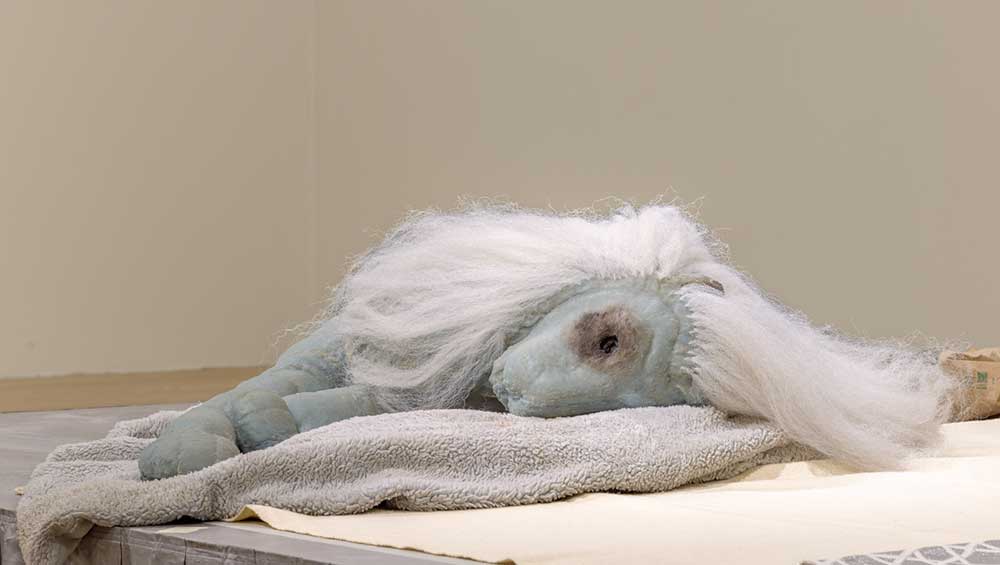
Liz Magor. Coiffed, 2020. Photo: Anna Lukala.
Focal Point Gallery, Southend-on-Sea
8 March – 10 June 2023
by TOM DENMAN
It is a glove. Grey, grooved. It could serve as an ashtray, as suggested by the cigarette, half-smoked, on a small, fluted holder that supports the butt. Ash is in the palm, fallen of its own accord or tapped by a finger. The glove is cast out of gypsum, though it resembles – so much so that, on one level, it is – real or fake leather that has been coloured light grey. The proximity of elements, of things made and things found, of the contingent and the not, germinate imagined interactions. For example, I could not put on the glove, even if permitted to try, but I think about it. The glove is rigid, and the opening is blocked by a piece of cardboard, also cast out of gypsum and the same colour as the glove. Although the cardboard blocks entry, it also holds open – or rather, the original cardboard kept open – the original glove, while they were being cast. The sculpture is on a coffee table with coffee stains. As far as I know, the table is real, as are the stains. The table could be a plinth. It belongs to the institution, where it is permanent, while in relation to the glove, it is as temporary as the ash, as the stains.
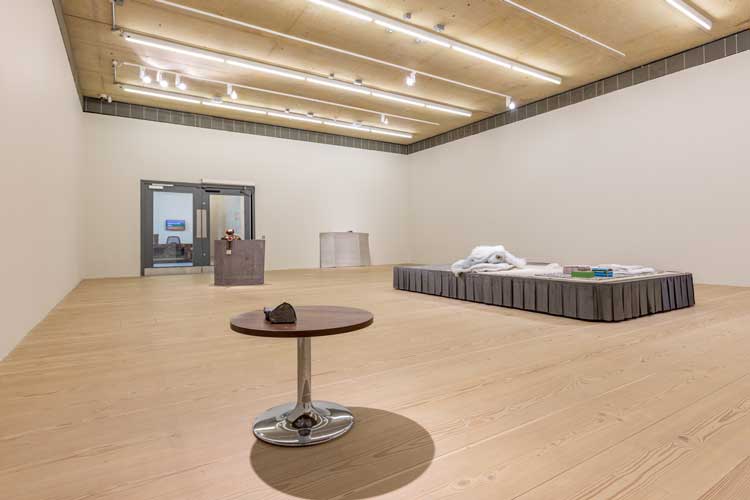
Liz Magor. Coiffed, Leather Palm, Oilmen’s Bonspiel. Photo: Anna Lukala.
What is a thing? What is a word? Liz Magor’s work insists on its own description, texturising words in anticipation of their utterance, and yet it skirts definition. We invent narratives and when we do we distance ourselves. There are clues, there are surprises and eureka moments that quickly fall flat, bringing us back to the details, to the whole, to the bafflement of describing, of what things are.
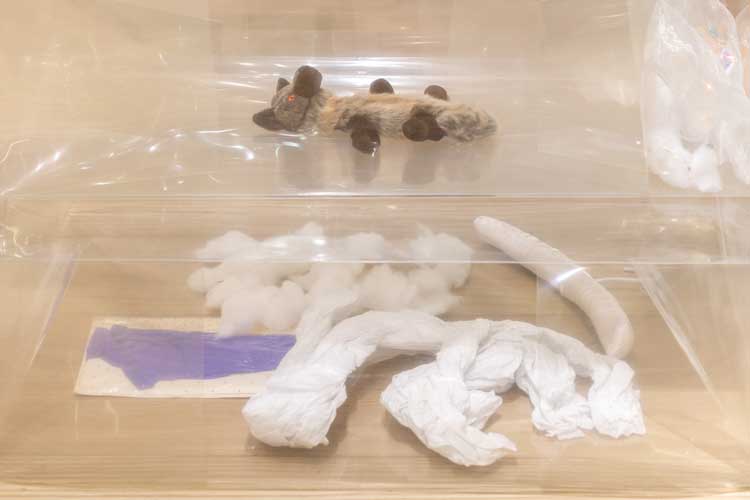
Liz Magor. Pet Co, 2018. Photo: Anna Lukala.
A stage. It is small, reeking of use and nostalgia. If nostalgia comes from use – that thing I wore again and again – the sense of use, the used, is nostalgia’s material counterpart. On it, a lion sleeps, or is dead, or both, or neither because it is not a real lion, on a white fluffy blanket that is no longer white and fluffy. The lion has a shiny grey-blue coat and a white mane, wispy like depigmented hair. The coat catches the light slimily, so I look closer … Nor is it a cuddly toy; it is cast out of waxy rubber. It could be marzipan, an idea difficult to stomach. The lion’s only visible eye has been burnt out, by a fat cigarette. The rest of the stage is covered in objects that, like the “original” lion, meant something to someone: a cream blanket, another smaller cloth with silver threading, a pile of folded white sheets, three jewellery boxes. On one box is written “Peace ’n’ Love”; another has an embroidered flower and the initials “EW”. On the corner of the blanket, adjacent to these initials, are the initials “LKN”. Beneath them I can see the tops of these same initials written on the stage, like shadows. Maybe belonging is a stamp: this belonged to someone, it belongs here.
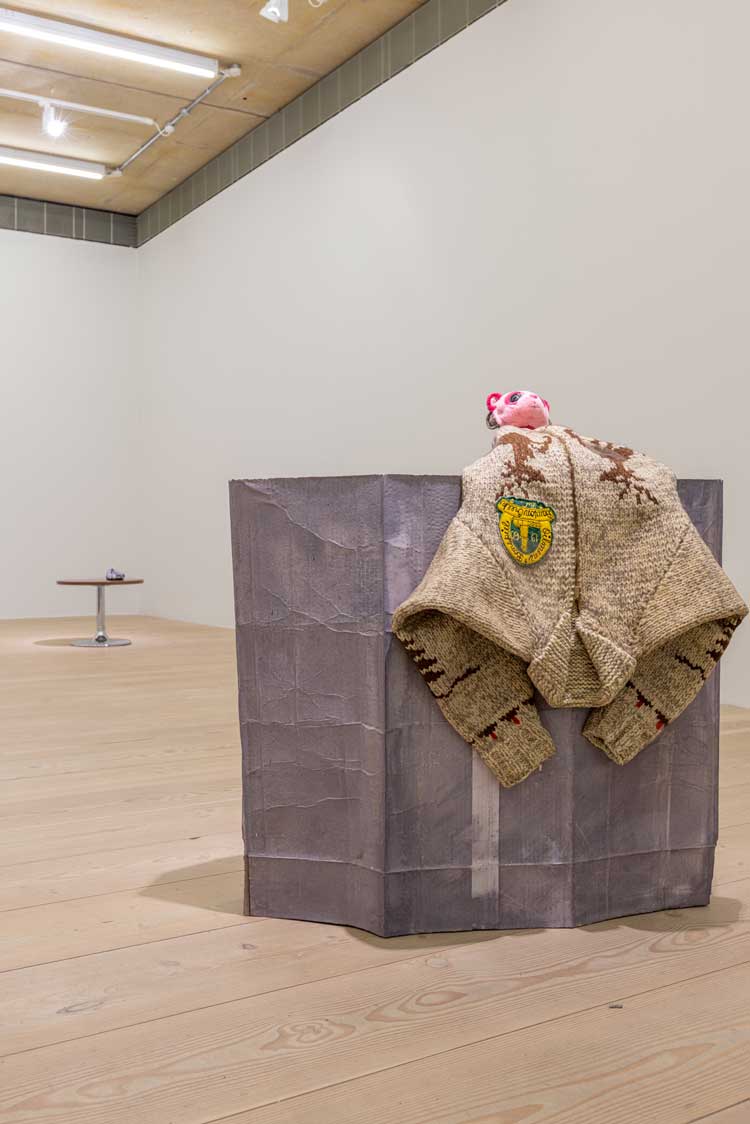
Liz Magor. Oilmen’s Bonspiel. Photo: Anna Lukala.
The lion could have been a prize, or it could have been the winner of a cuddly toy who decided she was that toy, and this is her sunken dream. But that is too sentimental, there is absolutely nothing sentimental about this (or any of Magor’s) work, or if there is, sentimentality rises and plummets back down again, quickly. It is a collection of objects on a stage found in the basement of an old hotel – no, too literal, too much fantasy. It is as if Magor has invented an in-betweenness where we are tempted to fantasise and do, but we are perpetually reined in, back to the materials and the things – all of which have stories, but stories that are better known to exist, as multiple and many, than be reinvented as such. In my case, the stories surely derive from the context of viewing, the gallery being in Southend-on-Sea, a land of amusement arcades and hotels “of an era”.
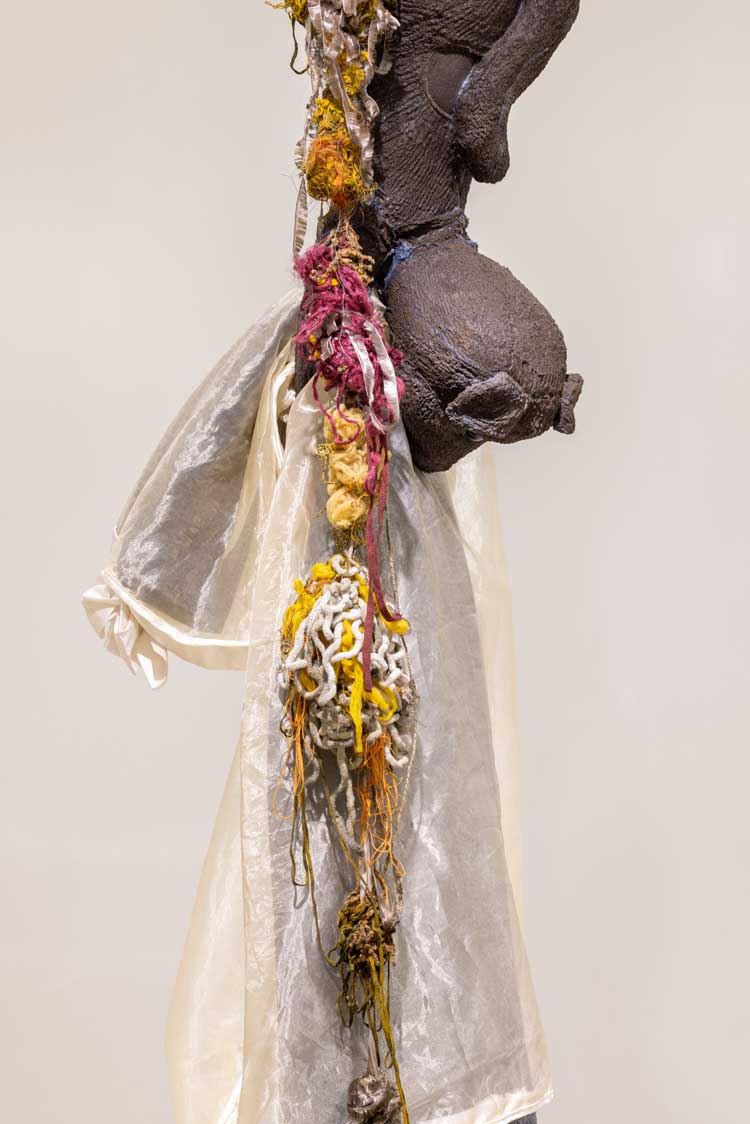
Liz Magor. Pet Co, 2018. Photo: Anna Lukala.
Only now do I think of Louise Bourgeois, who also incorporated blankets and initials, but these were things that she made or belonged to her, her initials. They were personal in a different way. Magor’s are personal objects that are not Magor’s, that have been collected, assembled, saved. This is repair by finding a home for something sewn, in art, in a sort of theatre, not by sewing. It would not be unreasonable to say that while Bourgeois estranges the familiar, Magor finds a home for the estranged – a home that is still unheimlich – while also pointing out the unhomeliness of all things.
The most fantasy-inducing works, or those that reach the imagination with found and noticeably old objects and a sense of contingency, are among Magor’s most recent, and these are in the first room. As well as the glove, Leather Palm (2019), and the lion, Coiffed (2020), there is Wasted (2021): a cardboard box cast out of gypsum. It is pockmarked. Half-finished squiggles dance on the grey, metallic surface, possibly dust, or an imitation of it. The “dusty” gypsum metallic cardboard leans solidly against the wall, becoming also an altar. On it is a taxidermy bird (definitely dead). The date “1887” is written in a period hand on a tag attached to its foot. Beneath the bird, a blue shadow has been painted, as if to translate the artificiality of its perseveration into a discourse about its being: it is not a ghost, or perhaps it could be, which is why its shadow is brushed on, or perhaps it is not a shadow, but a stain – the blue mimicking the oozy essence of the non-bird.
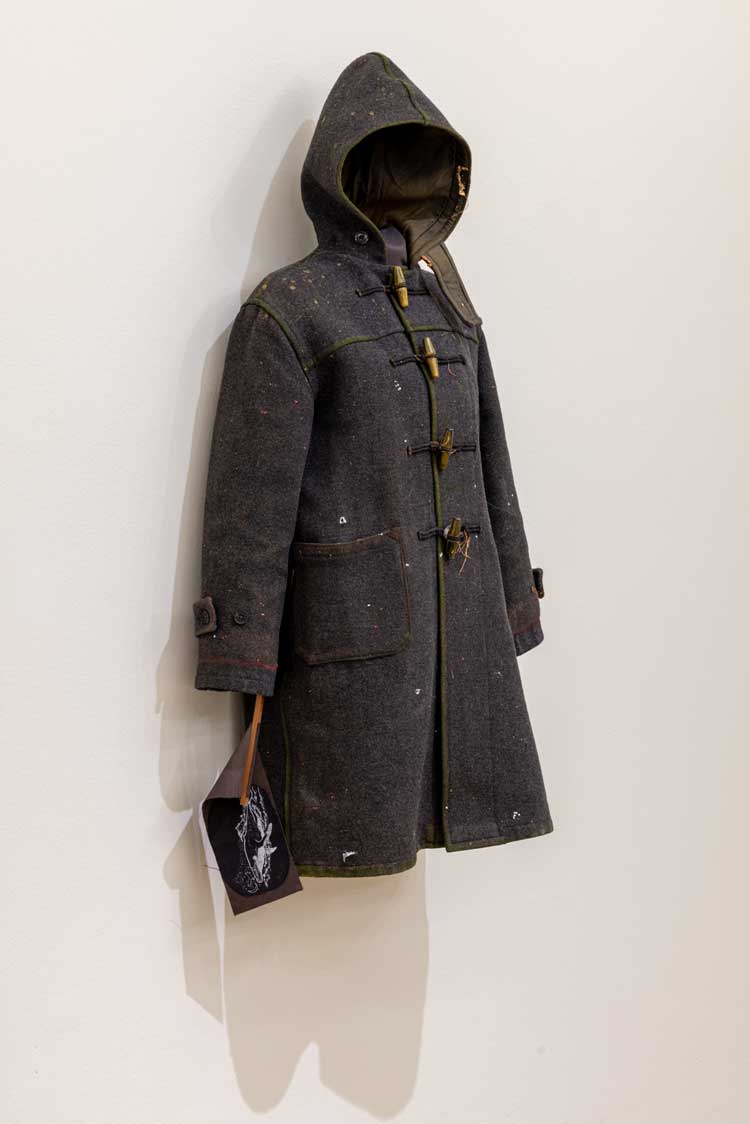
Liz Magor. Perennial, 2021. Photo: Anna Lukala.
There is also Perennial (2021), a spectral duffle coat with a flag with a picture of a humpback whale dangling from one sleeve, cookies and wrappers in one pocket and human hair meandering. Finally, there is Oilmen’s Bonspiel (2017), a gypsum-cast cardboard structure over which is a woollen jumper, held in place by a soft toy hugging it.
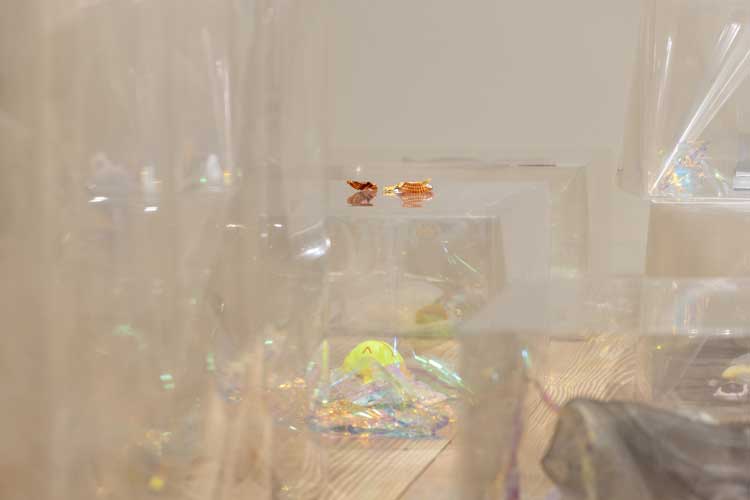
Liz Magor. Pet Co, 2018. Photo: Anna Lukala.
I had a cat once, and when he killed a mouse, he would magically regurgitate only the bits his stomach refused: head, feet, tail, certain organs. The rest, it seemed, would stay inside him. The other room is full of transparent, plastic boxes – an installation called Pet Co (2018), which reminds us that thingness, belonging and ownership are also about consumption. The boxes appear to contain fragments of light, shimmering, swimming, which sometimes deny visual access to what else is inside. Their walls are scarcely held together; their cuboidal, stacked order wants to explode. In them are dismembered, pastel-coloured stuffed toys – legs, heads, eyes – unfurled string and chocolate wrappers. Some animals, intact, wait to be eaten, and among them, slipped into the walls of the boxes, are real rat skins. The things – contents and containers – are entropic to the core, and yet as persistent as capitalism.
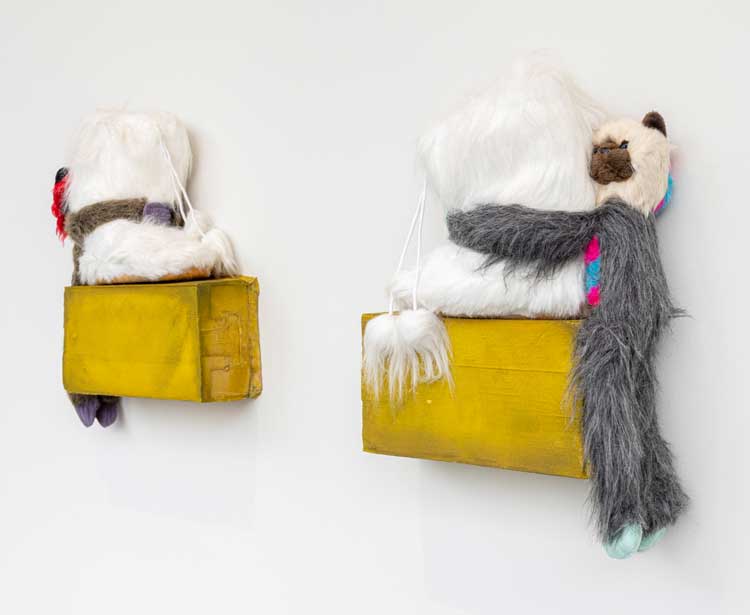
Liz Magor. The Boots, 2017. Photo: Anna Lukala.
Like the monkeys connecting the chuting chain of digested items in Delivery (Brown) (2018); like the furry hybrids clinging to the yeti boots on mustard-coloured, gypsum-cast bricks in The Boots (2017), displayed in the gallery window – they will hang on as long as we can.
• Liz Magor: The Rise and the Fall will tour to the Douglas Hyde Gallery of Contemporary Art, Dublin, from 14 July to 24 September 2023, and then to Fondazione Giuliani, Rome, from 26 October 2023 to January 2024.